Despite having a population of just under four million, Croatia has been a magnet for football talent since declaring its independence in 1991.
From Davor Šuker to Luka Modrić to Joško Gvardiol, the country has produced a stunning amount of world-class players that have graced football for over three decades now.
With the whole world on notice now after back-to-back World Cup medals in 2018 and 2022, there are more eyes than ever on the Croatian footballing scene, with everyone looking to snap up the next Modrić or Gvardiol at a lower cost.
Dinamo Zagreb and Hajduk Split are historically the two biggest clubs in the country and the biggest producers of talent who have gone on to do big things in the game.
Over the years, most of Croatia’s internationals came through the ranks at those clubs, at academy and first-team levels.
One of those exciting rising talents is 17-year-old centre-back Luka Vušković.
He stands at 1.93m (6’4’) and has done so since before the age of 15, which instantly distinguishes him from other players in his age group due to his tall frame and impressive physique.
He made his professional debut for Hajduk Split, for whom he was an academy graduate, at the age of 16 before signing a contract with Tottenham Hotspur later that same year, which would see him join in the summer of 2025 after he turns 18.
He spent the second half of last season on loan at Polish Ekstraklasa club Radomiak Radom before being picked up on another loan this summer, this time by KVC Westerlo in the Belgian Jupiler Pro League.
With a third of the season already played, Vušković has been a revelation.
The defender is even high on the league’s top scorer chart while being equally impressive at the back.
This analysis will examine Vušković’s development in Belgium so far this term and explain precisely why Tottenham fans should be excited about one of the hottest defensive talents in the world today.
Luka Vušković Data Analysis
Before discussing his different qualities, let’s examine the data regarding Vušković’s short time in Belgium.
Luka Vušković Defensive Territory & High Regains Chart
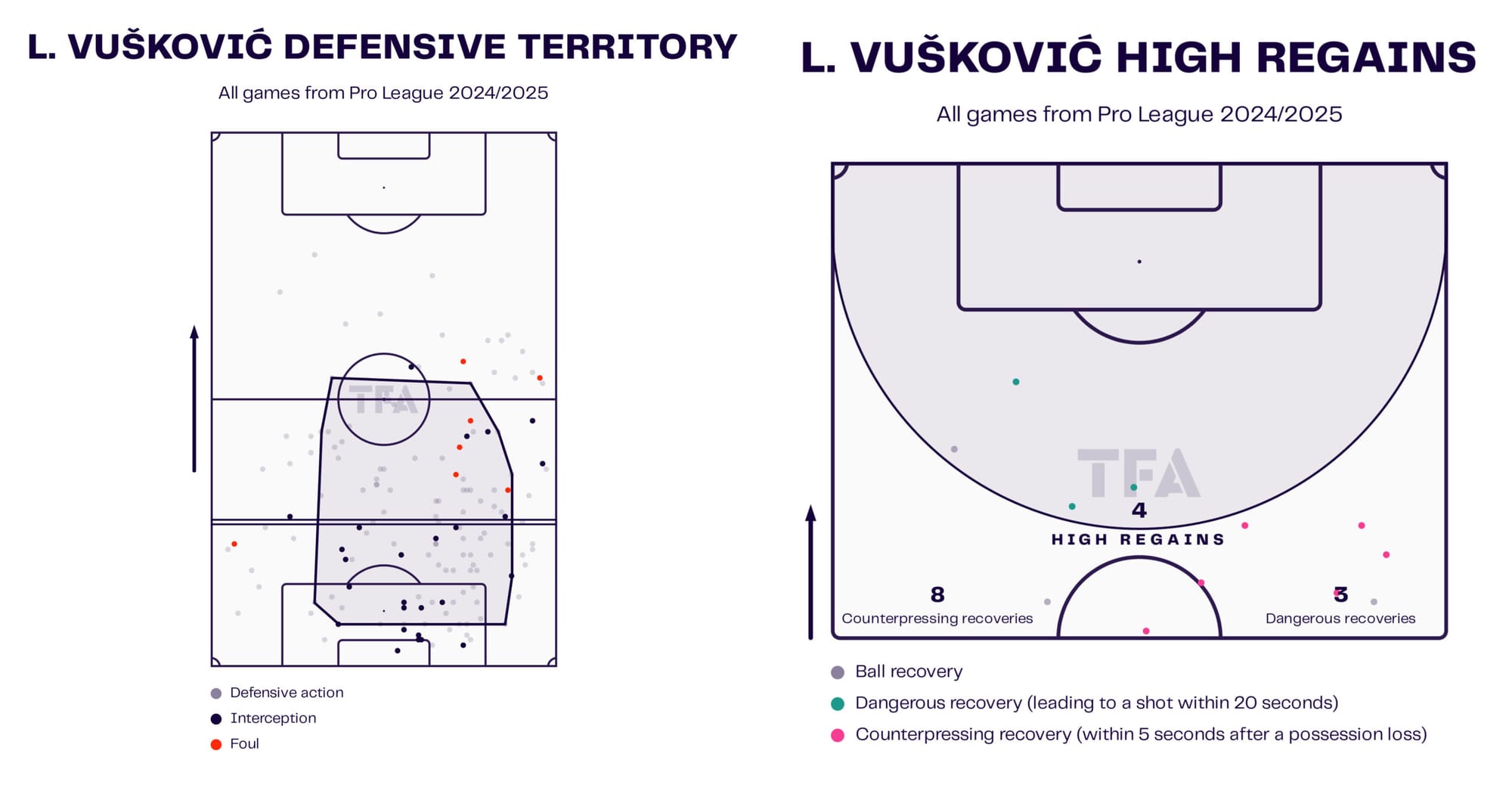
The above data visualisation highlights why Vušković has quickly become integral to Westerlo’s defensive plans.
Although Luka Vušković’s primary position is centre-back, he has experience operating as a defensive midfielder from his youth days, which is handy for him playing in Westerlo’s high line, where he is tasked with defending higher up the field.
With over a dozen high recoveries already this term, which can be seen on the right graphic, it’s clear that his all-around athleticism and abilities make him comfortable playing in this role and something Westerlo have made use of as part of their counter-pressing scheme when they lose the ball.
As his defensive territory map on the left graphic indicates, Vušković covers a lot of ground and makes defensive plays higher up the field, up to the centre of the pitch, where a high defensive line is normally positioned to attempt to squeeze the opposition.
Luka Vušković Penetrating Carries Chart
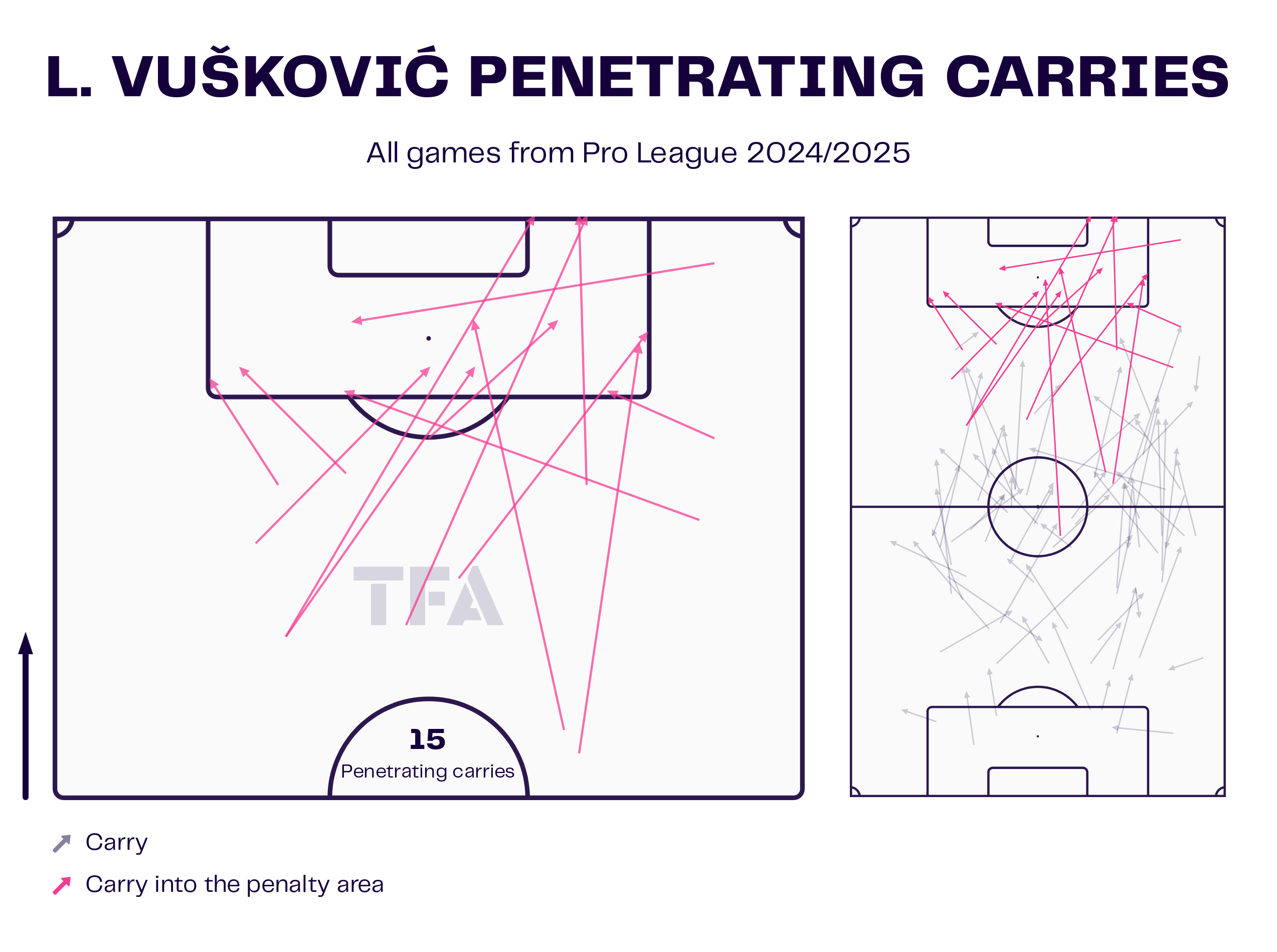
The data suggests that Vušković also contributes a lot to Westerlo on it in addition to his contributions off the ball.
With fifteen penetrating carries into the penalty area, he has carried the ball into the box far more than either of his centre-back partners this season, Roman Neustädter (2) and Emin Bayram (4), respectively, as well as Arthur Piedfort (7) although just shy of Doğucan Haspolat (19), Westerlo’s main double pivot pairing in their preferred 4-2-3-1 set-up.
These numbers paint a picture of how important Vušković is to the team’s build-up play, with his ball-carrying ability and ability to make long strides on the ball from deep.
Luka Vušković Heat Map & Touch Map
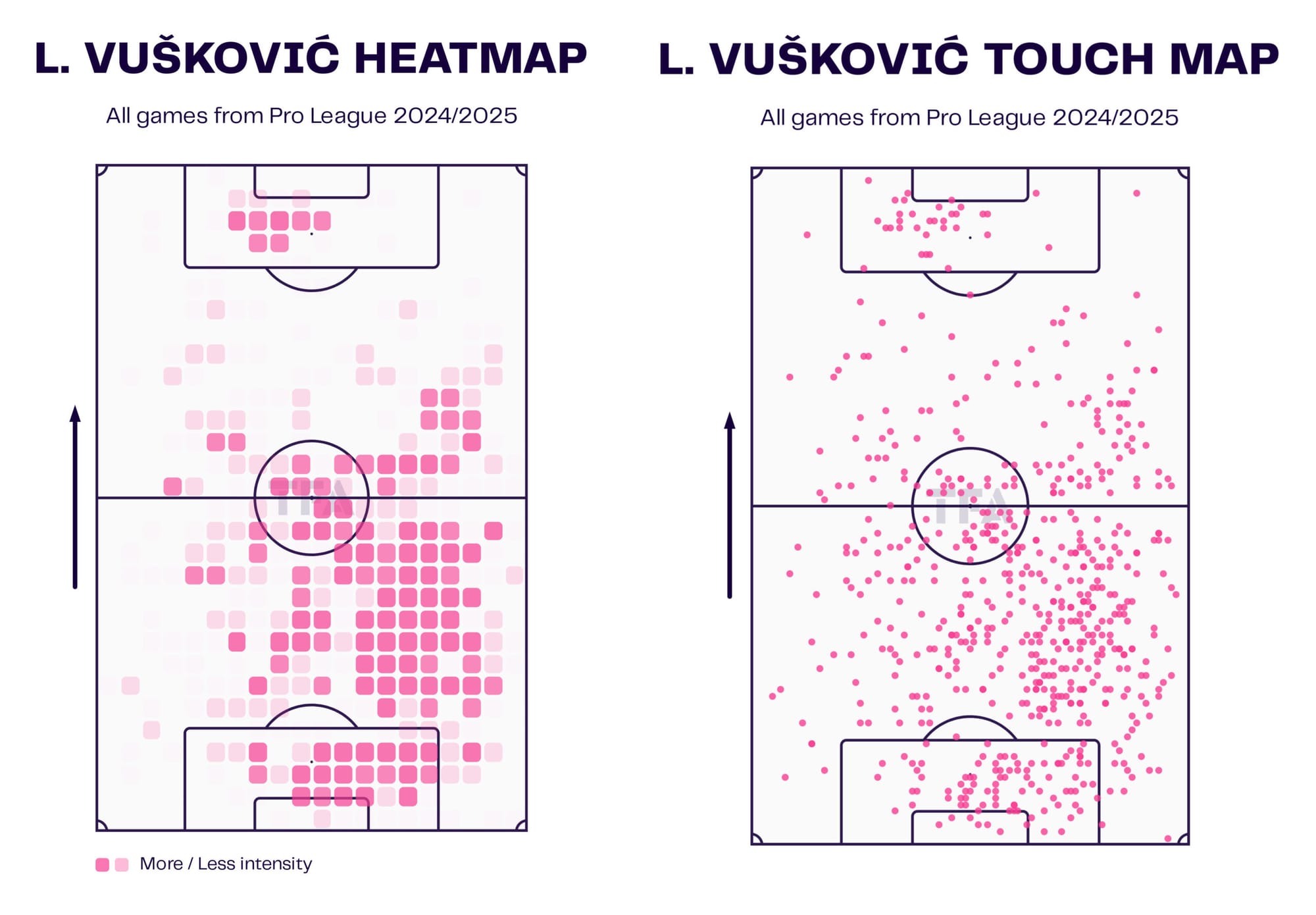
To support the previous points, we can examine his heat and touch maps this season, which further illustrate his involvement in the action.
These maps don’t look like the typical norm for a centre-back, even less so for someone as young as Vušković, but clearly, he is no ordinary player.
His high levels of activity and intensity on the field add a lot to what is already a pretty young Westerlo team and allow them to be a better version of themselves, knowing they have someone like Vušković at the back who can both clean up defensively and carry his load on the ball going forward.
Luka Vuškovic Strengths
As mentioned, the 1.93m Vušković has an exceptional build that gives him a significant advantage defensively and makes him an aerial threat on offensive set pieces.
But that isn’t all he is.
Vušković is also very mature and composed in all facets of his game, well beyond any expectations for a player of such a tender age as 17.
This analysis has already reviewed some of the data highlighting his value to Westerlo this season, both on and off the ball.
Now, let’s look at some examples in action.

The first thing that stands out about Vušković this season is that he’s already scored four times in the league and is Westerlo’s joint-top scorer despite being a centre-back.
To credit this would be the significant threat he poses on attacking set pieces, where almost all of his goals have come from.
With his tall frame and exceptional upper body strength for his age, it’s difficult to defend or beat him in the air, as teams in Belgium are finding out this season.
Above is the goal he scored at Mechelen, where his starting position is at the penalty spot and is marked with everything seemingly under control for the hosts.
And then he gets away from his marker to find himself on the end of a free header on the edge of the six-yard box to give his side the lead.
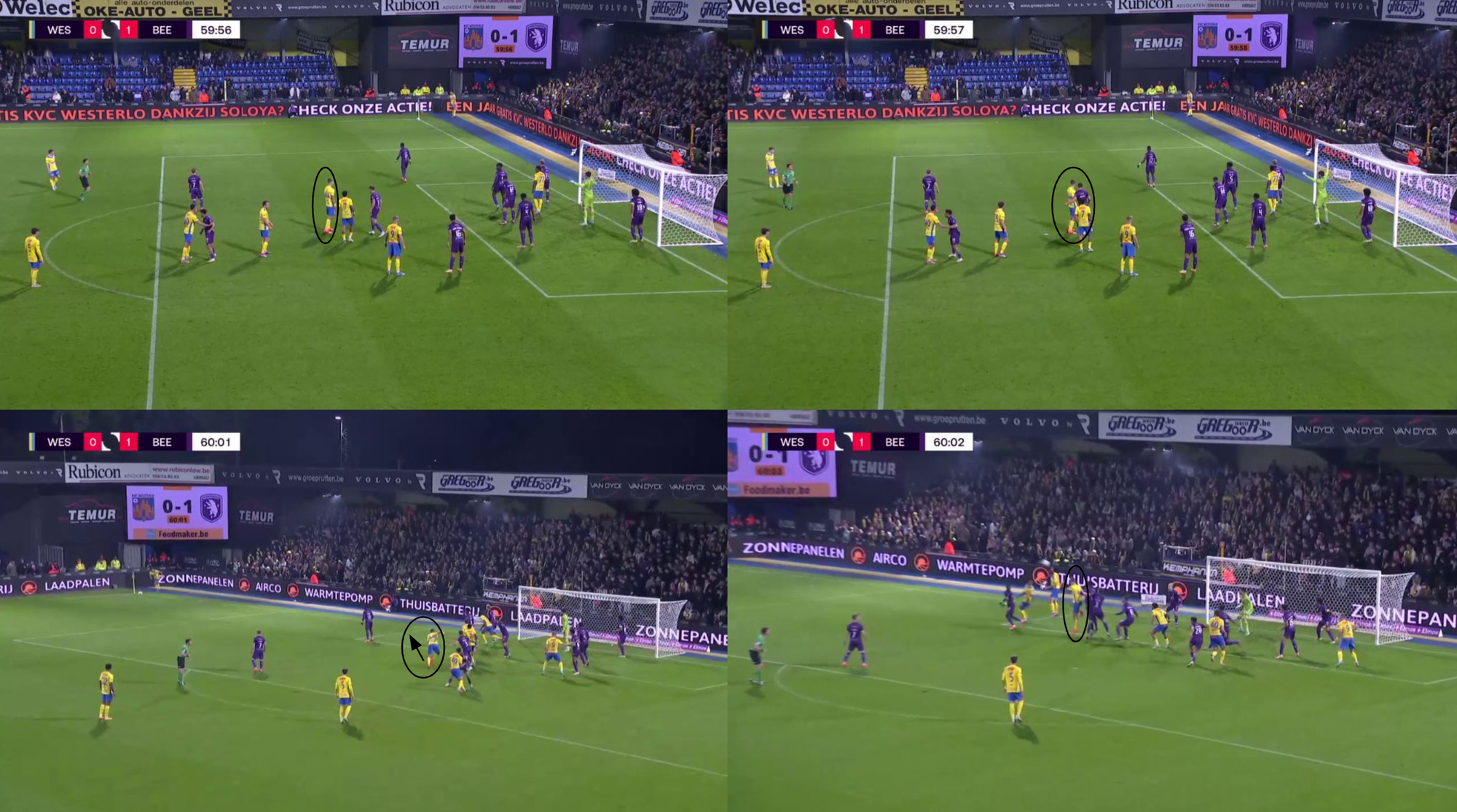
An identical situation occurred in the recent home game against Beerschot, where he scored twice and forced a great save, all from dead-ball situations.
Once again, his marker looks like he’s got him under control in the second pic above, but in one move as the ball is about to be delivered, Vušković frees himself again and sends a bullet header into the back of the net.
His runs on set plays are almost always the same, angled and towards the near post, but because of his size and strength, teams aren’t able to defend him if the delivery is right to him despite knowing what’s coming.
He has a Sergio Ramos-like quality—not a coincidence, given that the Spanish legend is one of Vušković’s footballing idols.
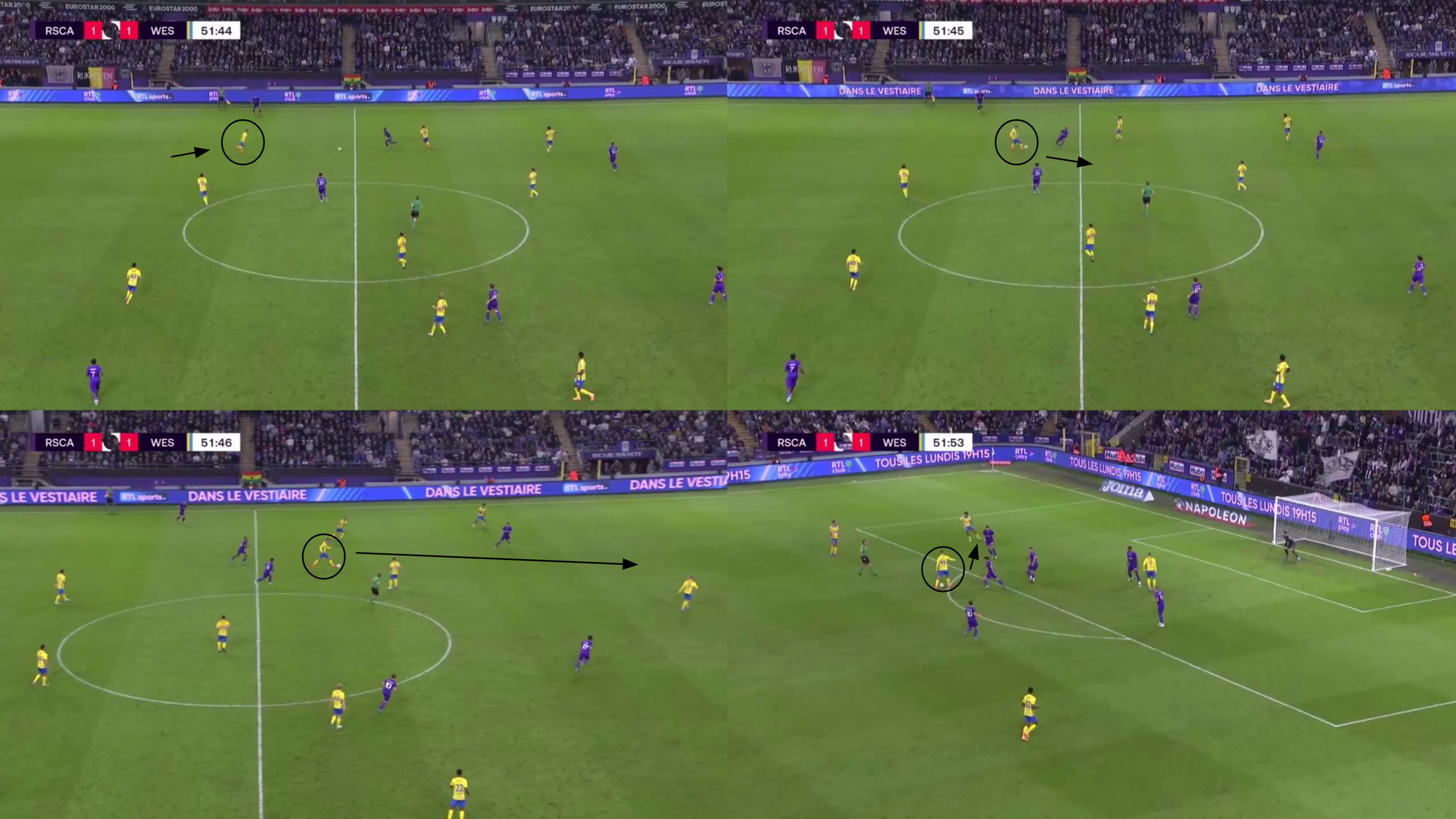
Another of his strengths, which has already been touched on during the data analysis, is his ability to get on the ball and carry it forward from the back.
The above example from the Anderlecht game highlights those qualities perfectly.
He initially pushes up from his central defensive position to prevent a counter-opportunity from brewing before noticing the space behind the onrushing Andrlecht forwards.
He then dinks the ball past both of them, which then frees him up to run into a large empty space and eventually arrive to the final third with options to shoot or pass to one of the forwards.
This sequence displayed his comfort on the ball, and while it didn’t lead to a goal, it was a fine taster of what he has in his repertoire when the situation presents itself.
Another thing that should be noted about this play is that he started on the left side of central defence, which he is capable of playing equally on the left and on the right and adept at using both feet when needed.

A point that was brought up earlier is how mature and composed Vušković is for his age.
Let’s look at a couple of plays that highlight those traits, both on and off the ball.
First, in the above graphic from the game against Royale Union SG, Vušković is put into a 1v1 defensive situation against a winger who has multiple options in this play to hurt Luka and Westerlo.
Instead of panicking in this situation like most 17-year-olds likely would, Vušković never once looked unsure and kept a strong defensive stance up against the opposing player.
Vušković followed his movements all the way, and when the winger came inside, he could stretch out his long leg to nick the ball off of him and regain possession for his team.
Thanks to his coolness and composure in defending the whole play, what could have been a dangerous situation was averted.

On the flip side, here’s another example from the same game where we can see his composure on the ball.
With Union pushing up to press with Vušković in possession, the Croat on the ball has very limited options in this situation.
Some would either play it hopelessly long or try to force a risky pass that could lead to a loss of possession.
Not Vušković, however, who instead uses his only outlet in Bryan Reynolds to play a quick combination to break Union’s two-man press before continuing into the opposition half with the ball on another one of his carrying runs.
These plays showcase a bit of Vušković’s exceptional maturity and intelligence for his age and what puts him beyond his years on the football pitch among much older, seasoned professionals.
These strengths are precisely why he’s been a hot commodity for clubs across Europe for a few years now.
Luka Vuškovic Areas For Improvement
Given the variety of skills and attributes he has covered in his locker so far, Luka Vušković’s style of play does not have any glaring weaknesses.
However, a couple of areas need improvement, especially if he is to realise his full potential and play for a top European side like his parent club, Tottenham, aspires to.
The most notable thing he could improve on would be his ball distribution in forward areas.
Here are a couple of examples of his pass selection and execution not meeting the high standards he’s set in other areas of his game.

This one is from the Beerschot game.
He is on another one of his ball-carrying runs out of the back and is under no pressure from the opposing players as he moves into the attacking third.
With five teammates across the line in attack and a couple of them making the run in behind for a lob pass, Vušković had plenty of options here and just needed to pick out the right one.
Instead, his ball was a total miscue, and he went out for a goal kick, which prevented anything from happening in a possible attacking situation.

And here’s another one, although this time from a deeper area where Standard Liége are putting him under some duress with a high press.
Although there are a couple of nearby options to try and play short to despite the risk of them being sucked into the press, he instead tries to go long on his left foot, and the ball gets cut out by a Standard player.
Standard have had offensive issues all season, so the chance to counter comes to nothing, but the inaccuracy here from Vušković could have put his side in danger with that space the opposition could have exploited.
So, while he is capable on the ball, as we’ve seen, he needs to improve to reach the highest level.
Let’s compare his current statistics there to those of the centre-back pairing of Cristian Romero and Micky van de Ven, which he’ll be looking to break up long-term when he moves to London.
Romero and van de Ven have an overall pass accuracy rate of over 90% in the Premier League this campaign, averaging over 65 passes a game.
In comparison, Vušković averages just 37 passes and an accuracy rate of 83%.
On passes into the final third, Romero has an 83% accuracy rate on 11 balls per game, van de Ven has an 89% rate on seven passes, and Vušković has just 74% with five on average per game.
Lastly, Romero averages an 84% accuracy rate for all forward passes with 27 balls per game, van de Ven 88% on 26 balls, and Vušković 66% on just 14 forward passes per game.
Romero and van de Ven’s numbers are much higher calibre when it comes to forward passing, all whilst playing at a higher level in the Premier League compared to the Belgian Jupiler League.
Ange Postecoglu likes both of his centre-backs to be technically high-standard on the ball to pull off his positive attacking style of play, in which Romero and van de Ven are in spades.
Vušković isn’t at that level currently with his ball-playing abilities, although the talent is obviously there.
But to be at the very top level of the game, he will have to improve in this area, as modern-day elite football demands high-quality ball-playing from the back across all the big teams.
The other area that could use some work is in the way he defends.

Sometimes, Vušković can be too eager and overestimate situations when defending, like above against Gent.
He steps out of his defensive position to try to win the ball but ends up clattering into his opponent’s back and conceding a foul.
Part of it concerns what his manager, Timmy Simons, asks of his players when they don’t have the ball to try to win it back.
But part of it is also Vušković showing that he still has some normal flaws for young players and will get cut out with experience.

It’s a different situation here from the Anderlecht game, but similar in how Vušković miscalculates and overestimates what he could do defensively to win the ball.
He pushes up out of defence again but ends up in no man’s land as Anderlecht find a way to combine around him and an empty space to move into behind.
Vušković ends up having no choice but to commit a tactical foul and pick up a booking, a situation that probably wouldn’t have happened if he had more experience.
Overall, though, defensively, he is ahead of where he should be, and any mistakes here and there should be eliminated with the more reps he gets.
But there is certainly still room for improvement for a player getting ready to move to Tottenham and the Premier League and compete with world-class players every week, in his own side and against others.
Conclusion
Luka Vušković is another big talent coming out of Croatia in recent years.
He will surely be a name we will continue to hear much about if his promising early professional career is anything to go by.
He possesses the talent, maturity, and right attitude that have already taken him far in a short space of time.
Even before the age of 18, he’s flourishing in a top-10 European league.
Tottenham and Croatia fans have much to be excited about with this player.
Given his high potential ceiling, he could be one of the best defenders in the world in a few years.

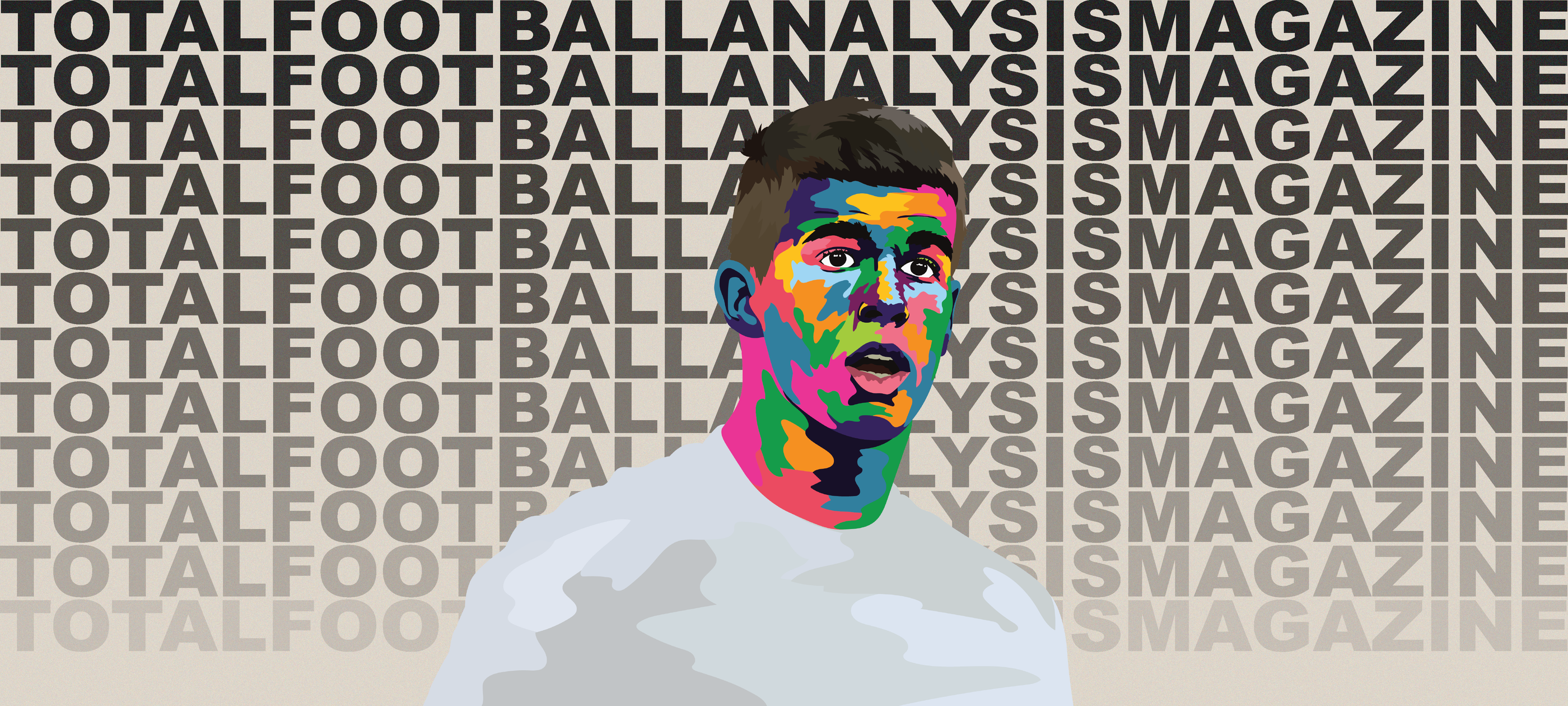




Comments